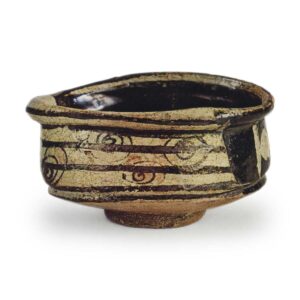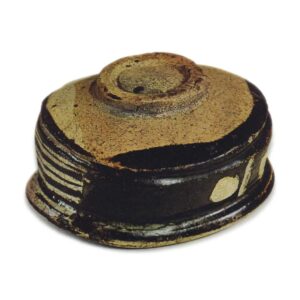

Height: 6.8 – 7.5cm
Diameter: 10.9 – 13.8cm
Outer diameter of foot ring: 5.6 – 5.8cm
Height of foot ring: 0.7cm
Black Oribe tea bowls are often seen, but Kutsu tea bowls are surprisingly rare, and even more so when they are of outstanding quality. The same is true of Shino ware, which has often been mentioned in tea ceremony records since ancient times, but many of the pieces that have come down to us are of uncertain origin.
This tea bowl is no exception, and although it has no particular history and is almost unrecognized, it is a typical example of the high-quality Oribe tea bowls that have been highly praised in recent years.
As for the Oribe-style tea bowls, in the tea ceremony records written by Kamiya Sotan, who was invited to a tea ceremony by Furuta Oribe in 1609, it is recorded that a tea bowl with a distorted, playful shape was used , it is not clear whether it was this type of black Oribe or Oribe black with a general black glaze, but it is thought that Oribe-style Kutsu-gata tea bowls were already being used at this time.
By the way, this tea bowl has a plain, upright, carved foot, which is unusual for a black Oribe tea bowl, and it seems too monotonous compared to the varied upper body, but on the other hand, it could be said that the casual way it was made makes the overall shape of the tea bowl more pleasing.
The hard, tightly-fired clay body is common to this type of tea bowl, but the area from the foot to the base is smooth, as if polished.
The style of the body, with a deep rounding of the rim near the waist and a strong outward curve at the rim, which emphasizes a sense of power, is also common to other tea bowls, but in this case it is carried out with absolute clarity, without hesitation.
The black glaze is applied to one side and the other is painted, but even on the side with the black glaze, the white-out pattern is revealed by scraping off the glaze, and the painted pattern on the other side is also unusual, with a spiral pattern arranged in horizontal stripes, and the color is expressed in the cast color through the thin white glaze applied on top.
Looking at the inside, it is unusual to see a picture of a lily, and the elegant ink painting-like picture here is a deliberate contrast to the light, geometric pattern on the side, and the ever-changing decorative nature of the piece is truly the domain of Oribe ware.
In general, Mino pottery is highly decorative, but this is particularly true of the Keicho period, and this tea bowl is probably from around the same time.
It is stored in a simple period box, and there is no writing on the lid. The paper covering the lid says “Setoguro tea bowl”, but the author and provenance are unclear.



